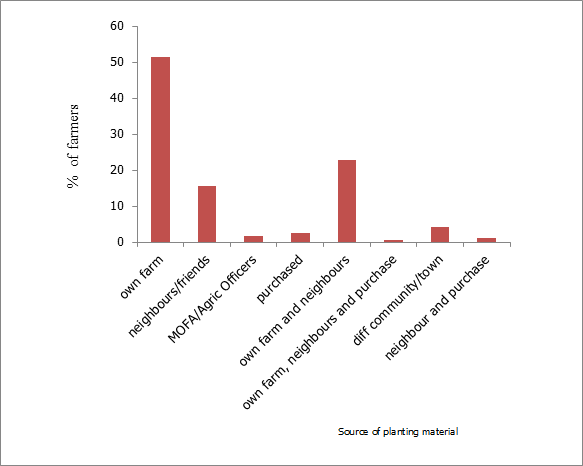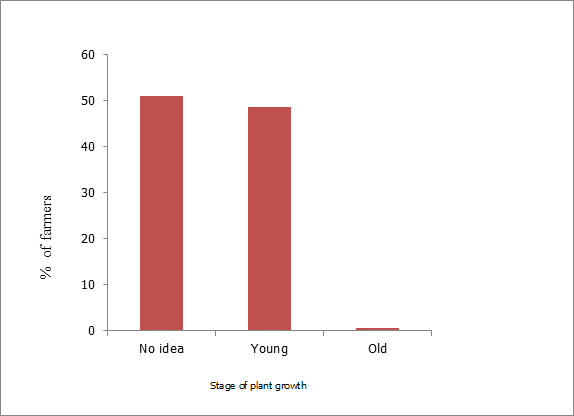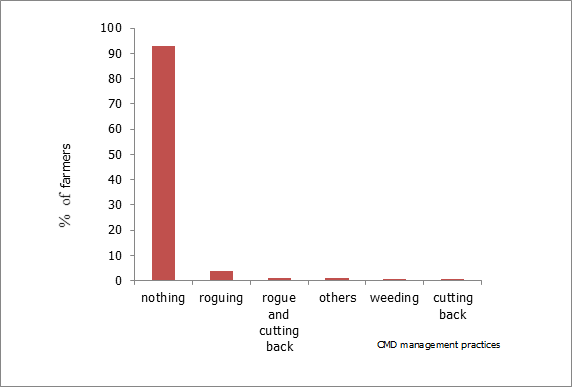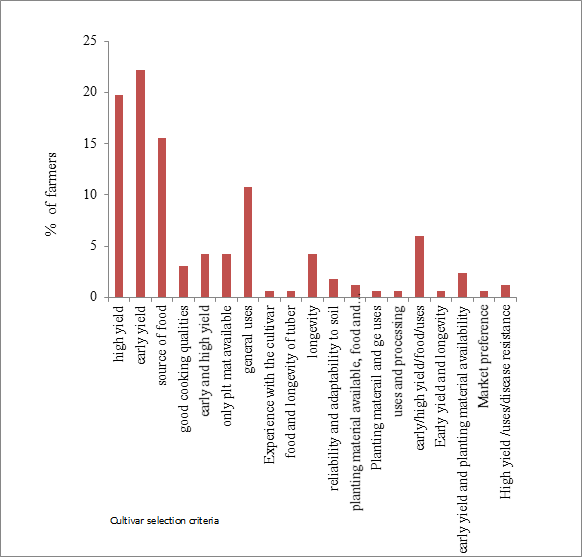Research Article
Volume 2 Issue 1 - 2017
Farmers’ Perception of Cassava Mosaic Disease and Cassava Cultivar Attributes Preferences in Ghana
1Forest and Horticultural Crops Research Centre-Kade, School of Agriculture, College of Basic and Applied Sciences, University of Ghana, Legon
2Department of Crop Science, School of Agriculture, College of Basic and Applied Sciences, University of Ghana, Legon
3Agricultural Research Organization, Volcani Centre, Israel
4West African Centre for Crop Improvement, University of Ghana, Legon
2Department of Crop Science, School of Agriculture, College of Basic and Applied Sciences, University of Ghana, Legon
3Agricultural Research Organization, Volcani Centre, Israel
4West African Centre for Crop Improvement, University of Ghana, Legon
*Corresponding Author: Stephen K Torkpo, Forest and Horticultural Crops Research Centre-Kade, School of Agriculture, College of Basic and Applied Sciences, University of Ghana, Legon.
Received: September 27, 2017; Published: October 28, 2017
Abstract
Farmers’ perception of cassava mosaic disease (CMD) was assessed in major cassava producing areas in the Eastern, Central, Brong Ahafo, Volta, Western, Northern and Ashanti regions of Ghana to harness their knowledge in formulating CMD management measures. A total of 167 questionnaires were administered to the cassava farmers. A greater proportion (approximately 72%) of farmers regarded CMD as important but rarely adopted control measures. Farmers’ choices for cultivars were largely driven by high yield, earliness and source of food. Approximately 52% of cassava farmers established their farms with planting materials from their own farms and nearly 16% sourced planting materials from neighbours. Farmers’ inadequate knowledge on CMD management practices and poor consideration of the health status of planting material was a threat to productivity of cassava. This requires concerted efforts from stakeholders to safeguard the cultivation of this important food security crop.
Keywords: Cassava mosaic disease; Farmers’; Perception; Ghana
Introduction
Cassava is an important staple food for many Africans (Thresh., et al. 1998; Nweke, 2004) and is one of the most efficient crops for carbohydrate production. Cassava is cultivated extensively in Ghana. It is an important food security crop and the most important staple in Ghana with per capita daily intake of 642 calories, far exceeding maize and rice with 434 and 217 calories, respectively (FAO, 2006) and contributes to about 22%of the country’s Agricultural gross domestic product (http://www.fao.org/docrep/009/a0154e/A0154E07.htm)
Ghana currently produces about 17 million metric tonnes of storage roots (MOFA, 2016). The importance of the crop is epitomized in its’ Ewe name, ‘agbeli’ meaning there is life. Cassava roots are consumed in the form of local products such as pounded boiled cassava (‘fufu’), boiled cassava (‘ampesi’), dried cassava chips (kokonte), granulated, toasted cassava root (gari) and ‘akyeke’ (a traditional food for the people of Nzema) (Balagopalan, 2002). Its roots are also used for animal feed (Nweke, 2004) and starch,which is used as raw material in many agro and agro allied industries (Olukunle andOlukunle, 2007) and ethanol for bio fuel and laboratory use (FAO, 2008). The leaves of sweet cassava are excellent for pot herb (Achidi., et al. 2005).
However, cultivation of cassava is constrained by several factors, including pests and diseases (Ntawuruhunga., et al. 2007). Cassava mosaic disease (CMD) has been regarded as the most important disease affecting productivity of cassava in many parts of sub-Saharan Africa (Sseruwagi., et al. 2004).
Cassava mosaic disease is caused by viruses of the genus: Begomovirus, family:Geminiviridae. The virus is transmitted by the whitefly (Bemisia tabaci) and disseminated through cuttings, which is the usual method of propagating the crop. CMD causes severe yield losses ranging from 20-95%, and the effect of the disease is more severe when plants are infected at the early stage of growth than when infected later (Thresh., et al. 1994). Annual CMD yield losses in Africa were estimated between US$1.9-2.7 billion (Legg and Fauquet, 2004).
CMD was first observed near Accra, Ghana in 1926 (Doku, 1966), and there had been subsequent studies on the disease in the country (http://www.fao.org/docrep/009/a0154e/A0154E07.htm Cudjoe., et al. 2005; Manu-Aduening., et al. 2007; Acheampong., et al. 2012).
Earlier works on perceptions of farmers on cassava diseases in the country although informative did not cover a wider area like the present study. And whereas their approach was participatory with closed questionnaires (Manu-Aduening., et al. 2007) and use of open ended questionnaires (Acheampong., et al. 2012), the authors of the present study used open ended questionnaires without participatory approach. Cassava farmers, (a very important stakeholder) in the cassava value chain were interviewed individually so as to build on existing knowledge. The objectives of the study were therefore to assess perception of cassava farmers about CMD in Ghana, sources of planting material, farmer-preferred attributes of cassava cultivars for effective and efficient CMD management.
Methodology
Survey area and questionnaire
The study was conducted from June 2005 to January 2008 and involved 167 cassava farmers selected randomly from major cassava producing regions in Ghana. About 30% of the cassava farmers were selected from the Eastern region (Fanteakwa, Birim South, Akwapem South, West Akim and Suhun/Kraboa/Coaltar), 18% from Central region (Mfantseman, Agona and Awutu/Efutu/Senya), 14% Brong Ahafo region (Techiman, Atebubu, Asutifi, Wenchi, Sene, Berekum, Asunafo South, Tano South and Nkoranza), 13% from Volta region (Krachi West, Krachi East, Jasikan, Nkwanta, Hohoe, South Dayi), 11% from Western region (SefwiWiaso, Aowin-Suaman, Juaboso, Wassa Amenfi West and Wassa Amenfi East), 7% from Northern region (Gonja East, GonjaWest, Nanumba South and Nanumba North) and 6% from Ashanti region (Amansie East, AhafoAno South, Atwima Nwabiagya, Atwima Mponua, Bosomtwe Atwima Kwahoma, Asante Akim North and Ejisu Juabeng).
The study was conducted from June 2005 to January 2008 and involved 167 cassava farmers selected randomly from major cassava producing regions in Ghana. About 30% of the cassava farmers were selected from the Eastern region (Fanteakwa, Birim South, Akwapem South, West Akim and Suhun/Kraboa/Coaltar), 18% from Central region (Mfantseman, Agona and Awutu/Efutu/Senya), 14% Brong Ahafo region (Techiman, Atebubu, Asutifi, Wenchi, Sene, Berekum, Asunafo South, Tano South and Nkoranza), 13% from Volta region (Krachi West, Krachi East, Jasikan, Nkwanta, Hohoe, South Dayi), 11% from Western region (SefwiWiaso, Aowin-Suaman, Juaboso, Wassa Amenfi West and Wassa Amenfi East), 7% from Northern region (Gonja East, GonjaWest, Nanumba South and Nanumba North) and 6% from Ashanti region (Amansie East, AhafoAno South, Atwima Nwabiagya, Atwima Mponua, Bosomtwe Atwima Kwahoma, Asante Akim North and Ejisu Juabeng).
Information was collected from the cassava farmers using open-ended questionnaire. Seven key questions that were asked:
- Whether cassava mosaic disease was considered important?
- What stage of plant infection do you consider important?
- What do you do when infection occurs?
- What informs your choice of planting material?
- What is/are the source of planting material?
- Number of cassava cultivars grown
- Intercrops grown
Statistical analysis
Data gathered was analyzed using SPSS version 16.0 for windows. Questionnaires were numbered and the questions were coded prior data entry. Analysis was done using descriptive statistics and results presented with bar charts.
Data gathered was analyzed using SPSS version 16.0 for windows. Questionnaires were numbered and the questions were coded prior data entry. Analysis was done using descriptive statistics and results presented with bar charts.
Results
Majority of the cassava fields of respondents rarely exceeded one hectare and were mostly established with local cassava genotypes. Most (69%) of the 167 respondents’ fields were intercropped with mostly food crops such as maize, cocoyam, plantain, okra, yam, cowpea, sorghum, garden eggs, and on some occasions with other crops such as cocoa, teak and pineapple. Cassava mixtures (growing more than one cassava genotypes on a field) were also very common in both monocropped or intercropped fields.
Most of the respondents [120 (71.9 %) out of 167] indicated that CMD was important. Nearly half of the respondents [81 (48.5%)] were of the view that CMD was important when young plants were infected whereas 85 (50.9%) had no idea about which stage of plant growth was critical for the development of disease. A single respondent (0.6%) indicated that the disease was important when older plants were affected by CMD (Figure 1).
When asked, what CMD management practices they carry out when CMD sets in, majority of respondents [154 (92%) out of 167] indicated that they did not take any action when plants were infected with CMD (Figure 2). Farmers’ choice of a cultivar was largely driven by attributes such as source of food, high yield and earliness of bulking. Twenty-two percent (22.2%) of the farmers interviewed considered ‘early yield only’ when choosing a cultivar and 19.8% and 15.6% considered ‘high yield only’ and source of food only, respectively (Figure 3). Only two (i.e., 1.2%) respondents considered the health status of planting materials when choosing a cultivar.
Most of the respondents 85 (51.5%) used planting materials from their own farms. Twenty-six respondents (15.6%) sourced planting materials from their neigh bours in establishing new farms and 22.8% said they established new farms with planting materials form neigh bours or their own farms. Farmers rarely sourced planting materials from MOFA/Agric Officers (Figure 4).

Figure 4: Farmers sources of cassava planting material. This figure gives the various sources where cassava planting materials are obtained.
Discussion
Farmers’ perceptions about crop diseases greatly influence adoption ofintervening measures such as deployment of resistant cultivars and good management practices. Consistent with findings made in Ghana (Cudjoe., et al. 2005; Manu-Aduening., et al. 2007), Benin (Gbaguidi., et al. 2005) and Kenya (Mallowa., et al. 2006) a good proportion of farmers perceived cassava mosaic disease as important. This finding in the present study was contrary to Poubom., et al. (2005), who reported that in Cameroun, damages due to diseases such as CMD, cassava anthracnose disease (CAD) and cassava bacteria blight (CBB) were not considered serious constraints compared to damages caused by vertebrates, grasshoppers and root rots. The survey also showed that cassava farmers in Ghana hardly adopted CMD management practices which prevent spread of the disease. Similar observations were reported by Gbaguidi., et al. (2005), who conducted a survey among farmers in Benin but contradicted the findings in Cameroon (Ntonifor., et al., 2005), where nearly 30% percent of respondent practiced rouging, with the reaming practicing other management practices.
Despite recognizing the importance of CMD, the low proportion (1.2%) of respondents who considered the health status of planting materials during material selection was far less than the 18% reported by Manu-Aduening., et al. (2007). Farmers normally established their farms with materials from their previous season’s plantings and neighbours’ farms. Similar results were reported in the country (Cudjoe., et al. 2005; Manu-Aduening., et al. 2007) and Nigeria (Echendu., et al. 2005) but in Tanzania, Chikoti., et al. (2016), reported that about one-third of farmers obtained their cuttings for planting from Ministry of Agriculture and Cooperatives. An important setback of this approach was that farmers usually harvested vigorous and good looking plants earlier and cuttings from these plants most often dry-out before the next planting season and could not be used for planting. This would consequently result in use of otherwise infected cuttings during cropping seasons and further compound the CMD problem. Kiros-Meles and Abang (2008) have reported that even when farmers had access to disease-resistant or disease-tolerant cultivars, they grew susceptible local cultivars (landraces) because of various reasons including earliness, and high yield. The higher rating for high yield and early bulking reported in the current study was consistent with Chikoti., et al. (2016)
However, the results of the present study showed that farmers generally lacked knowledge or were unaware of CMD-resistant cultivars and hence, cultivated local CMD-susceptible landrace, as was observed by Mallowa., et al. (2006) in their study of cassava cultivation by farmers in the Siaya district of western Kenya. Predominance of local genotypes in cassava cropping systems have also been reported by Chikoti., et al. (2016), and could be due to the extent to which farmer preferred attributes such as food type (e.g. ampesi, konkonte, fufu,agbelima, agbelikakro, etc.) might have been met by those genotypes or inaccessibility to improved varieties (Acheampong., et al. 2012)which met their preferred attributes, thus requiring more farmer education.
Conclusions
Farmers were aware of the importance of CMD but barely carried out disease management measures. Farmers rarely considered health status of planting materials when selecting cassava genotypes for planting. Farmers mostly established their farms with cuttings from their own farms or from neigh bours. Three major deciding attributes for cultivating a cassava cultivar were high yield, earliness to bulk and uses. With high CMD prevalent rate in the country (Torkpo., et al. unpublished), it is important for a concerted effort by cassava farmers, policy makers, processors and other stakeholders to combat the threat posed by CMD to food security in the country. Emphasis should be placed on efficient cropping practices and Phyto sanitation in managing the disease while efforts were being made to develop, evaluate, multiply and introduce large quantities of resistant and farmer preferred’ varieties to combat the CMD problem.
References
- Acheampong PP., et al. “Cassava variety attributes preferences in Ashanti, BrongAhafo and Eastern regionsof Ghana”. Ghana Journal of Agricultural Science 45 (2012): 21-18.
- Achidi AU., et al. “The Use of Cassava Leaves as Food in Africa” Ecology of Food and Nutrition 44.6 (2005): 423-435.
- Balagopalan C. “Cassava utilization in food, feed and Industry”. Cassava: Biology, production and Utilization (2002): 301-318.
- Chikoti PC., et al. “Farmer’s Perception of Cassava Mosaic Disease, Preferences and Constraints in Lupaula Province of Zambia”. American Journal of Plant Sciences 7.7 (2016): 1129-1138.
- Cudjoe A., et al. “Chapter 1.2 (Ghana) In: Whiteflies and Whitefly- borne Viruses in the Tropics: Building a knowledge Base for Global Action”. P.K. Anderson, F.J. Morales, A.L. Jones and R.H. Markham (Eds), Arte LibroImpresores, Cali. Colombia (2005): 24-29.
- Doku EV. “Root crops in Ghana”. Ghana Journal of Science 6 (1966): 15-36.
- Echendu NC., et al. “Chapter 1.4 (Nigeria) In: Whiteflies and Whitefly- borne Viruses in the Tropics: Building a knowledge Base for Global Action”. P.K. Anderson, F.J. Morales, A.L. Jones and R.H. Markham (Eds), Arte LibroImpresores, Cali. Colombia. (2005): 35-39.
- FAO. “FAO year book on Ghana”. (2006):
- FAO. (2008): http://www.fao.org/newsroom/en/news/2008/1000899/index.html
- Gbaguidi B., et al. “Chapter 1.3 (Benin) In: Whiteflies and Whitefly-borne Viruses in the Tropics: Building a knowledge Base for Global Action”. P.K. Anderson, F.J. Morales, A.L. Jones and R.H. Markham (Eds), Arte LibroImpresores, Cali. Colombia. (2005): 30-34.
- http://www.fao.org/docrep/009/a0154e/A0154E07.htm
- Kiros-Meles A and Abang MM. “Farmers’ knowledge of crop diseases and control strategies in the Regional State of Tigrai, northern Ethiopia: implications for farmer–researcher collaboration in disease management in the field”. Agriculture and Human Values 25.3 (2008): 433-452.
- Legg JP and Fauquet CM. “Cassava mosaic geminiviruses in Africa”. Plant Molecular Biology 56.4 (2004): 585-599.
- Mallowa SO., et al. “Current characteristics of cassava mosaic disease in post epidemic areas increase the range of possible management options”. Annals of Applied Biology 149.2 (2006): 137-144.
- Manu-Aduening JA., et al. “Farmers’ perceptions and knowledge of cassava pests and diseases and their approach to germplasm selection for resistance in Ghana”. Annals of Applied Biology 151.2 (2007): 189-198.
- MOFA. “Ministry of Food and Agriculture, Statistics, Research and Information Directorate (SRID), Accra, Ghana”. (2016):
- Ntawuruhunga P., et al. “Incidence and severity of cassava mosaic disease in the Republic of Congo”African Crop Science Journal 15.1 (2007): 1-9.
- Ntonifor N., et al. “Chapter 1.4 (Nigeria) In: Whiteflies and Whitefly- borne Viruses in the Tropics: Building a knowledge Base for Global Action”. P.K. Anderson, F.J. Morales, A.L. Jones and R.H. Markham (Eds), Arte LibroImpresores, Cali. Colombia. (2005): 40-45.
- Nweke F. “New challenges in the cassava transformation in Nigeria and Ghana”. EPTD DISCUSSION PAPER 118 (2004):
- Olukunle OJ and Olukunle OF. “Development of a Sustainable System for Cassava Starch Extraction”. University of Kassel-Witzenhausen and University of Göttingen, October 9-11, 2007, Conference on International Agricultural Research for Development. (2007):
- Poubom CFN., et al. “Farmers' perceptions of cassava pests and indigenous control methods in Cameroon”. International Journal of Pest Management 51.2 (2005): 157-164.
- “Statistical package for social sciences version 16.0 for windows”.
- Sseruwagi P., et al. “Methods of surveying the incidence and severity of cassava mosaic disease and whitefly vector populations in Africa: a review”. Virus Research 100.1 (2004): 129-142.
- Thresh JM., et al. “Effects of African cassava mosaic geminivirus on the yield of cassava”. Tropical Science 34 (1994): 26-42.
- Thresh JM., et al. “The control of African cassava mosaic virus disease: phytosanitation and/ resistance? In: Plant Virus Disease Control”. A, Hadidi, R. K. Kheterpal and H. Koganezawa (eds.), APS Press, St Paul. Minnesota, USA (1998): 670-677.
Citation:
Stephen K Torkpo., et al. “Farmers’ Perception of Cassava Mosaic Disease and Cassava Cultivar Attributes Preferences in
Ghana”. Innovative Techniques in Agriculture 2.1 (2017): 294-300.
Copyright: © 2017 Stephen K Torkpo., et al. This is an open-access article distributed under the terms of the Creative Commons Attribution License, which permits unrestricted use, distribution, and reproduction in any medium, provided the original author and source are credited.
































 Scientia Ricerca is licensed and content of this site is available under a Creative Commons Attribution 4.0 International License.
Scientia Ricerca is licensed and content of this site is available under a Creative Commons Attribution 4.0 International License.